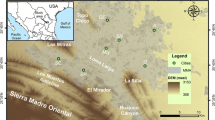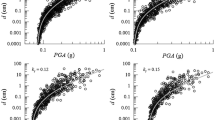Abstract
Earthquake-induced landslides are responsible worldwide for significant socioeconomic losses and historically have a prominent position in the list of natural hazards affecting the Iran plateau. As a step toward the development of tools for the assessment and the management of this kind of hazard at regional scale, an empirical estimator of coseismic displacements along potential sliding surfaces was obtained through a regression analysis for the Zagros region, a mountainous Iranian region subjected to earthquake-induced landslides. This estimator, based on the Newmark’s model, allows to evaluate the expected permanent displacement (named “Newmark displacement”) induced by seismic shaking of defined energy on potential sliding surface characterized by a given critical acceleration. To produce regression models for Newmark displacement estimators, a data set was constructed for different critical acceleration values on the basis of 108 accelerometric recordings from 80 Iranian earthquakes with moment magnitudes between 3.6 and 7. The empirical estimator has a general form, proposed by Jibson (Eng Geol 91:209–218, 2007), relating Newmark displacement to Arias intensity (as parameter representing the energy of the seismic forces) and to critical acceleration (as parameter representing the dynamic shear resistance of the sliding mass). As an example of application, this relation was employed to provide a basic document for earthquake-induced landslide hazard assessment at regional scale, according to a method proposed by Del Gaudio et al. (Bull Seismol Soc Am 93:557–569, 2003), applied to the whole Iranian territory, including Zagros region. This method consists in evaluating the shear resistance required to slopes to limit the occurrence of seismically induced failures, on the basis of the Newmark’s model. The obtained results show that the exposure to landslide seismic induction is maximum in the Alborz Mountains region, where critical accelerations up to ~0.1 g are required to limit the probability of seismic triggering of coherent type landslides within 10% in 50 years.






Similar content being viewed by others
References
Ambraseys NN, Menu JM (1988) Earthquake-induced ground displacements. Earthq Eng Struct Dyn 16:985–1006
Ambraseys NN, Srbulov M (1995) Earthquake induced displacements of slopes. Soil Dyn Earthq Eng 14:59–71
Amini Hosseini K (2005) Landslides triggered by Firuzabad-e-Kojur earthquake. International Institute of Earthquake Engineering and Seismology (in Persian)
Bender B, Perkins DM (1987) SEISRISK III: a computer program for seismic hazard estimation. US Geol Surv Bull 1772:48
Capolongo D, Refice A, Mankelow J (2002) Evaluating earthquake-triggered landslide hazard at the basin scale through GIS in the upper selle river valley. Surv Geophys 23:595–625
Carro M, De Amicis M, Luzi L, Marzorati S (2003) The application of predictive modeling techniques to landslides induced by earthquakes: the case study of the 26 September 1997 Umbria–Marche earthquake (Italy). Eng Geol 69:139–159
Crespellani T, Madiai C, Vannucchi G (1998) Earthquake destructiveness potential factor and slope stability. Geotechnique 48(3):411–419
De Mets C, Gordon RG, Argus DF, Stein S (1990) Current plate motions. Geophys J Int 101:425–478
Del Gaudio V, Wasowski J (2004) Time probabilistic evaluation of seismically induced landslide hazard in Irpinia (Southern Italy). Soil Dyn Earthq Eng 24:915–928
Del Gaudio V, Pierri P, Wasowski J (2003) An approach to time-probabilistic evaluation of seismically induced landslide hazard. Bull Seismol Soc Am 93:557–569
Engdahl ER, Van der Hilst RD, Buland RP (1998) Global teleseismic earthquake relocation with improved travel times and procedures for depth determination. Bull Seismol Soc Am 88:722–743
Haeri SM, Sattari MH (1993) large landslides triggered by Manjil earthquakes. International Institute of Earthquake Engineering and Seismology (In Persian)
Jafari MK, Montazerolghaem S, Mahdavifar MR, Heydari M (2000) Studies on landslides triggered by Alborz earthquakes. International Institute of Earthquake Engineering and Seismology (In Persian)
Jibson RW (1993) Predicting earthquake-induced landslide displacements using Newmark’s sliding block analysis. Transp Res Rec 1411:9–17
Jibson RW (2007) Regression models for estimating coseismic landslide displacement. Eng Geol 91:209–218
Jibson RW, Harp EL, Michael, JM (1998) A method for producing digital probabilistic seismic landslide hazard maps: an example from the Los Angeles, California area. US Geological Survey Open-File Report 98-113. 17 pp
Jibson RW, Harp EL, Michael JM (2000) A method for producing digital probabilistic seismic landslide hazard maps. Eng Geol 58:271–289
Jibson RW, Harp EL, Schulz W, Keefer DK (2004) Landslides triggered by the 2002 M-7.9 Denali Fault, Alaska, earthquake and the inferred nature of the strong shaking. Earthq Spectra 20:669–691
Keefer DK (1984) Landslides caused by earthquakes. Geol Soc Am Bull 95:406–421
Keefer DK (2002) Investigating landslide caused by earthquakes-a historical review. Surv Geophys 23:473–510
Komak Panah A, Hafezimoghadas N (1993) landslides hazard zonation in Iran. International Institute of Earthquake Engineering and Seismology (In Persian)
Luzi L, Pergalani F (2000) A correlation between slope failures and accelerometric parameters: the 26 September 1997 earthquake (Umbria Marche, Italy). Soil Dyn Earthq Eng 20:301–313
Mahdavifar MR (2006) Analytical evaluation and design of the system (GIS) for seismic landslides hazard/risk management in Iran. Dissertation, International Institute of Earthquake Engineering and Seismology, 213 pp (in Persian)
Mahdavifar MR, Solaymani Sh, Jafari MK (2002) Landslides triggered by the Avaj, Iran earthquake of June 22. Eng Geol 86:166–182
Mahdavifar MR, Jafari MK, Zolfaghari MR (2007) The attenuation of Arias Intensity in Alborz and Central Iran. In: Proceedings of the 5th international conference on seismology and earthquake engineering. Tehran, Iran
Mahdavifar MR, Jafari MK, Zolfaghari MR (2008) Real-time generation of arias intensity and seismic landslides hazards maps using GIS. J Seismol Earthq Eng (JSEE) 10(2):81–90
Mankelow JM, Murphy W (1998) Using GIS in the probabilistic assessment of earthquake triggered landslide hazards. J Earthq Eng 2:593–623
Miles SB, Keefer DK (2000) Evaluation of seismic slope performance models using a regional case study. Environm Eng Geosci 6:25–39
Miles SB, Keefer DK (2001) Seismic Landslide Hazard for the City of Berkeley, California. US Geological Survey miscellaneous Field Studies Map MF-2378
Murphy W, Mankelow JM (2004) Obtaining probabilistic estimates of displacement on a landslide during future earthquakes. J Earthq Eng 8:133–157
Newmark NM (1965) Effects of earthquakes on dams and embankments. Geotechnique 15:139–159
Nogolsadat M (1996) ground movement hazard in Gilan Province (In Persian)
Rajabi AM (2010) Probabilistic assessment of earthquake-induce landslides hazard in Iran, Dissertation, Tarbiat Modares University, Tehran, Iran 238 pp (in Persian)
Rajabi AM, Khamechian M, Mahdavifar MR, Del Gaudio V (2010) Attenuation relations of arias intensity for Zagros mountains region (Iran). Soil Dyn Earthq Eng 30(3):110–118
Rathje EM, Bray JD (2000) Nonlinear coupled seismic sliding analysis of earth structures. J Geotech Geoenvironm Eng 126:1002–1014
Rathje EM, Saygili G (2008) Probabilistic seismic hazard analysis for the sliding displacement of slopes-Scalar and vector approaches. J Geotech Geoenvironm Eng 134:804–814
Refice A, Capolongo D (2002) Probabilistic modeling of uncertainties in earthquake-induced landslide hazard assessment. Comput Geosci 28:735–749
Romeo R (2000) Seismically induced landslide displacements: a predictive model. Eng Geol 58:337–351
Saygili G, Rathje EM (2008) Empirical predictive models for earthquake-induced sliding displacements of slopes. J Geotech Geoenvironm Eng 134:790–803
Sinaiean F (2006) A study on the strong ground motions in Iran (from catalog to attenuation relationship), Dissertation, International Institute of Earthquake Engineering and Seismology, 318 p (in Persian)
Talebian M, Jackson J (2002) A reappraisal of earthquake focal mechanisms and active shortening in the Zagros mountains of Iran. Geophys J Int 156:506–526
Tatar M, Hatzfeld D, Ghafory-Ashtiany M (2003) Tectonics of the Central Zagros (Iran) deduced from microearthquake seismicity. Geophys J Int 156:255–266
Tavakoli B (1996) Major Seismotectonic provinces of Iran. Unpublished map, International Institute of Earthquake Engineering and Seismology, Internal document
Tavakoli B, Ghafory-Ashtiany M (1999) Seismic hazard assessment of Iran. Ann Geofis 42(6):1013–1021
Tofigh Reihani MH (2002) Geology of Avaj Changure earthquake. Building and Housing Research Center (In Persian)
Wilson RC, Keefer DK (1985) Predicting the aerial limits of earthquake- induced landsliding. In: Ziony JI (ed) Evaluating earthquake hazards in the Los Angeles region-an earth science perspective. US Geol Surv Profess Pap 1360: 316–345
Acknowledgments
The authors thank Dr. J. Wasowski for the insightful comments and useful suggestions.
Author information
Authors and Affiliations
Corresponding author
Additional information
A. M. Rajabi—Graduated from Tarbiat Modares University, Tehran, Iran
Rights and permissions
About this article
Cite this article
Rajabi, A.M., Mahdavifar, M.R., Khamehchiyan, M. et al. A new empirical estimator of coseismic landslide displacement for Zagros Mountain region (Iran). Nat Hazards 59, 1189–1203 (2011). https://doi.org/10.1007/s11069-011-9829-1
Received:
Accepted:
Published:
Issue Date:
DOI: https://doi.org/10.1007/s11069-011-9829-1




